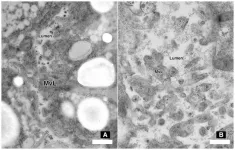(Press-News.org) SAN ANTONIO, Jan. 14, 2025 – Scientists from The University of Texas Health Science Center at San Antonio (UT Health San Antonio) and Trinity University are partnering with the San Antonio Food Bank for a four-year, $2.2 million study on eating disorders in older Hispanic women.
A grant from the National Institute on Aging of the National Institutes of Health is funding this transformative study, which aims to redefine how the intersection of binge eating, food insecurity and health disparities among older Hispanic women is understood and addressed. The idea is to reduce multimorbidity, pioneer scalable interventions and deliver actionable insights for policymakers.
“The goal is understanding, in this population living with significant intersectional disadvantage, how the trajectories of both food insecurity and binge eating over time operate independently on health and how do they transact and potentially influence one another,” said Lisa Smith Kilpela, PhD, associate professor with the Department of Medicine at UT Health San Antonio, and associate director of its Center for Research to Advance Community Health (ReACH).
She and Carolyn Black Becker, PhD, professor of psychology at Trinity University in San Antonio, are the lead investigators for the study titled, “Prospective Health Impacts of Chronic Binge Eating Disorder in Hispanic Older Women Living with Food Insecurity (PROSPERA).”
During the study, the San Antonio Food Bank will serve as a centralized location for study-related activities and provide infrastructure to support the research process.
Intersection of age, food insecurity, culture
The study is expected to build on one published in 2023 by Kilpela, Becker and other scientists that found between 17% and 20% of a sample of women aged 51 or older who visited the San Antonio Food Bank met the criteria for severe binge eating disorder.
When Kilpela saw this new grant opportunity related to underserved populations, she was eager once again to partner with Becker, a pioneer in the study of eating disorders among people living with food insecurity. The new study narrows the scope of the previous one to focus on potential health impacts for Hispanic women.
Findings of this study could inform treatment options and policy changes that better understand how food insecurity, age and culture intersect to affect the health of Hispanic women living with binge eating disorder.
One of the objectives is to create a new risk index for this population. Factors that typically predict binge eating behaviors might not be as relevant for all people, including women of color and underrepresented populations.
This study proposes to include 250 Hispanic women, age 50 or older, living with food insecurity, with 125 who meet the criteria for chronic binge eating disorder and 125 who have no history of an eating disorder.
Throughout the study, researchers will assess the impact of binge eating disorders on participants’ mental and physical health compared to participants who are food insecure but do not have an eating disorder. The study will include qualitative interviews with participants about their lived experiences and major life events.
In the end, researchers hope to pinpoint certain factors that influence the health burden of binge eating disorder among older Hispanic women living with food insecurity and develop relevant interventions that health care providers and nonprofit organizations can use.
“Many of our older women know they’ve been left behind,” Kilpela said. “They know they’ve been struggling but (they) say nobody ever asked them about this. It’s significant to be able to give a voice to people who are very aware that they have been marginalized.
“That is why a big part of our work is to give a voice to those who’ve been left behind, to serve the underserved, to tackle health disparities where they exist and where we don’t even realize they exist,” she said.
Community partnerships
“What makes this study truly innovative is the leveraging of three great San Antonio institutions – UT Health San Antonio, Trinity University and the San Antonio Food Bank – to address the health needs of an underserved community in San Antonio all while advancing science in a critically needed area,” Becker said. “This is a San Antonio study from start to finish.”
Said Emily De Maria, MPAff, chief programs officer with the San Antonio Food Bank, “By serving as the central point of contact for both participants and researchers, the food bank will help enhance participant engagement and support the overall success of the study.”
Study participants can access point-of-care testing, health counseling and case management. As part of the research plan, UT Health San Antonio and Trinity University scientists pledge to conduct annual virtual food drives for the San Antonio Food Bank and complete at least 40 volunteer hours annually.
The study will provide compensation totaling $45,000 to participants through HEB grocery gift cards, the value of the health screenings, one-hour phone counseling sessions and connections to additional resources.
Throughout the project, the team will conduct focus groups with community members and stakeholders, gather community input and conduct qualitative interviews to determine what steps to take next.
Getting past the label
Kilpela, for her part, has been a leading expert on eating disorders in older women, although her first clinical research was on eating disorders of a population that fits a preconception of the disease – young, white, affluent and female.
“We’ve put a great deal of our time, our energy and our money into understanding how eating disorders affect a very specific population, based on this stereotype,” Kilpela said.
Kilpela said most geriatricians she’s spoken with had never asked their patients about eating disorders. And yet research suggests that up to 20% of women over the age of 60 have chronic binge eating disorder, defined as eating abnormally large amounts of food in one sitting while feeling out of control, one or more times per week over at least three months.
Reasons for the disorder vary from person to person, but some correlations include stress, poor body image and depression.
Recent data reveals that binge eating disorders and related health conditions are significantly more common among older women, particularly those experiencing food insecurity. These women often struggle with poorer mental health, reduced quality of life and a higher prevalence of chronic illnesses such as diabetes, heart disease and high blood pressure.
Kilpela said that during her first postdoctoral fellowship with Becker, they discussed the widespread assumptions about eating disorders, including the stereotype that body image concerns and related eating disorders naturally improve with age. Diving into the data, they found that women aged 60 years and older have some of the highest levels of body dissatisfaction.
“Why do we think that body image or eating disorders would get better with age when what you see everywhere on TV and the media is not just the thin ideal, but the young, thin ideal?” Kilpela said.
The University of Texas Health Science Center at San Antonio (UT Health San Antonio), a primary driver of San Antonio’s $44.1 billion health care and biosciences sector, is the largest academic research institution in South Texas with an annual research portfolio of $413 million. Driving substantial economic impact with its six professional schools, a diverse workforce of more than 8,500, an annual expense budget of $1.46 billion and clinical practices that provide 2.6 million patient visits each year, UT Health San Antonio plans to add more than 1,500 higher-wage jobs over the next five years to serve San Antonio, Bexar County and South Texas. To learn about the many ways “We make lives better®,” visit UTHealthSA.org.
Stay connected with The University of Texas Health Science Center at San Antonio on Facebook, Twitter, LinkedIn, Instagram and YouTube.
END
Breaking barriers: Collaborative research studies binge eating disorders in older Hispanic women
UT Health San Antonio, Trinity, Food Bank join on $2.2 million NIH grant
2025-01-14
ELSE PRESS RELEASES FROM THIS DATE:
UVA receives DURIP grant for cutting-edge ceramic research system
2025-01-14
The University of Virginia School of Engineering and Applied Science is set to revolutionize materials science with the development of a state-of-the-art electromagnetic levitation (EML) system, funded by a competitive Defense University Research Instrumentation Program (DURIP) grant. Designed to operate in extreme conditions, the system enables researchers to study ultra-high-temperature ceramics (UHTCs) in their solid and molten states — unlocking new possibilities for aerospace, defense and industrial applications.
Rethinking High-Temperature Research
Traditional methods of studying UHTCs are limited by the challenges of chemical contamination at extreme temperatures. The EML system’s ...
Gene editing extends lifespan in mouse model of prion disease
2025-01-14
Researchers at the Broad Institute of MIT and Harvard have developed a gene-editing treatment for prion disease that extends lifespan by about 50 percent in a mouse model of the fatal neurodegenerative condition. The treatment, which uses base editing to make a single-letter change in DNA, reduced levels of the disease-causing prion protein in the brain by as much as 60 percent.
There is currently no cure for prion disease, and the new approach could be an important step towards treatments that prevent the disease or ...
Putting a lid on excess cholesterol to halt bladder cancer cell growth
2025-01-14
LA JOLLA (January 14, 2025)—Like all cancers, bladder cancer develops when abnormal cells start to multiply out of control. But what if we could put a lid on their growth?
Previous studies showed that a protein called PIN1 helps cancers initiate and progress, but its exact role in tumor development has remained unclear. Now, cancer biologists at the Salk Institute have discovered that PIN1 is a significant driver of bladder cancer and revealed that it works by triggering the synthesis of cholesterol—a membrane lipid essential for cancer cells to grow.
After mapping out the molecular pathway between PIN1 and ...
Genetic mutation linked to higher SARS-CoV-2 risk
2025-01-14
RIVERSIDE, Calif. -- Researchers have identified a novel genetic risk factor for SARS-CoV-2 infection, providing new insights into the virus’ ability to invade human cells. SARS-CoV-2 is the virus that spreads COVID-19.
The study, led by immunologist Declan McCole at the University of California, Riverside, shows that a loss-of-function variant in the phosphatase gene PTPN2, commonly associated with autoimmune diseases, can increase expression of the SARS-CoV-2 receptor ACE2, making cells more susceptible to viral invasion.
A loss-of-function ...
UC Irvine, Columbia University researchers invent soft, bioelectronic sensor implant
2025-01-14
Irvine, Calif., Jan. 14, 2025 — Researchers at the University of California, Irvine and New York’s Columbia University have embedded transistors in a soft, conformable material to create a biocompatible sensor implant that monitors neurological functions through successive phases of a patient’s development.
In a paper published recently in Nature Communications, the UC Irvine scientists describe their construction of complementary, internal, ion-gated, organic electrochemical transistors that are more amenable ...
Harnessing nature to defend soybean roots
2025-01-14
The microscopic soybean cyst nematode (SCN) may be small, but it has a massive impact. This pest latches onto soybean roots, feeding on their nutrients and leaving a trail of destruction that costs farmers billions in yield losses each year. Unfortunately, current methods to combat SCN are faltering as the pest grows resistant to traditional controls. But new research is now offering a glimmer of hope.
A collaborative team of scientists from BASF Agricultural Solutions and the Advanced Bioimaging Laboratory at the Donald Danforth Plant Science Center are working on a potential solution: ...
Yes, college students gain holiday weight too—but in the form of muscle not fat
2025-01-14
With the holidays behind us, many Americans are seeing the numbers on the scale go up a pound or two. In fact, data shows that many American midlife and older adults gain 1 to 1.5 pounds over the November through January holiday period. Though not harmful on its own, even a small amount of holiday weight gain in the form of fat can negatively affect health. People often fail to lose the extra weight, which leads to significant cumulative weight gain over the years and contributes to health concerns.
Based on new research, we now know that college students gain the same amount of weight as older ...
Beach guardians: How hidden microbes protect coastal waters in a changing climate
2025-01-14
A hidden world teeming with life lies below beach sands. New Stanford-led research sheds light on how microbial communities in coastal groundwater respond to infiltrating seawater. The study, published Dec. 22 in Environmental Microbiology, reveals the diversity of microbial life inhabiting these critical ecosystems and what might happen if they are inundated by rising seas.
“Beaches can act as a filter between land and sea, processing groundwater and associated chemicals before they reach the ocean,” said study co-first author Jessica Bullington, a Ph.D. student in Earth system science in the Stanford Doerr School of Sustainability. “Understanding ...
Rice researchers unlock new insights into tellurene, paving the way for next-gen electronics
2025-01-14
HOUSTON – (Jan. 14, 2025) – To describe how matter works at infinitesimal scales, researchers designate collective behaviors with single concepts ⎯ like calling a group of birds flying in sync a “flock” or “murmuration.” Known as quasiparticles, the phenomena these concepts refer to could be the key to next-generation technologies.
In a recent study published in Science Advances, a team of researchers led by Shengxi Huang, associate professor of electrical and computer engineering and materials science and nanoengineering at Rice, describe how one such type of quasiparticle ⎯ polarons ⎯ behaves in tellurene, a nanomaterial first synthesized ...
New potential treatment for inherited blinding disease retinitis pigmentosa
2025-01-14
Two new compounds may be able to treat retinitis pigmentosa, a group of inherited eye diseases that cause blindness. The compounds, described in a study published January 14th in the open-access journal PLOS Biology by Beata Jastrzebska from Case Western Reserve University, US, and colleagues, were identified using a virtual screening approach.
In retinitis pigmentosa, the retina protein rhodopsin is often misfolded due to genetic mutations, causing retinal cells to die off and leading to progressive blindness. Small molecules to correct rhodopsin folding are urgently needed to treat the estimated 100,000 ...
LAST 30 PRESS RELEASES:
How human interaction drove evolution to make bears less aggressive
National Poll: Few parents offer teens guidance on healthy eating during holiday season
Cannabis derivatives could provide new ovarian cancer treatments
Raising strong yeast as a petroleum substitute
Clues to the origin of hot Jupiters hidden in their orbits
Canada’s reduced pledge to Global Fund will impact domestic health
1 in 4 children with major traumatic injuries not cared for in pediatric trauma centres
Duke and Duke-NUS’ joint cross-population research to uncover "East-West" differences in disease and care
Scientists to ‘spy’ on cancer- immune cell interactions using quantum technology breakthrough
Tech savvy users have most digital concerns
Making lighter work of calculating fluid and heat flow
Normalizing blood sugar can halve heart attack risk
Lowering blood sugar cuts heart attack risk in people with prediabetes
Study links genetic variants to risk of blinding eye disease in premature infants
Non-opioid ‘pain sponge’ therapy halts cartilage degeneration and relieves chronic pain
AI can pick up cultural values by mimicking how kids learn
China’s ecological redlines offer fast track to 30 x 30 global conservation goal
Invisible indoor threats: emerging household contaminants and their growing risks to human health
Adding antibody treatment to chemo boosts outcomes for children with rare cancer
Germline pathogenic variants among women without a history of breast cancer
Tanning beds triple melanoma risk, potentially causing broad DNA damage
Unique bond identified as key to viral infection speed
Indoor tanning makes youthful skin much older on a genetic level
Mouse model sheds new light on the causes and potential solutions to human GI problems linked to muscular dystrophy
The Journal of Nuclear Medicine ahead-of-print tip sheet: December 12, 2025
Smarter tools for peering into the microscopic world
Applications open for funding to conduct research in the Kinsey Institute archives
Global measure underestimates the severity of food insecurity
Child survivors of critical illness are missing out on timely follow up care
Risk-based vs annual breast cancer screening / the WISDOM randomized clinical trial
[Press-News.org] Breaking barriers: Collaborative research studies binge eating disorders in older Hispanic womenUT Health San Antonio, Trinity, Food Bank join on $2.2 million NIH grant





